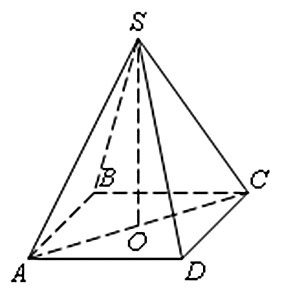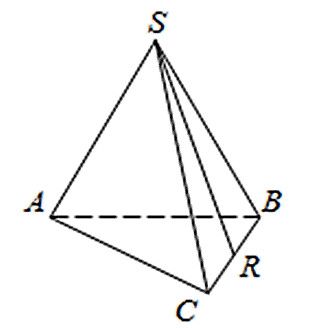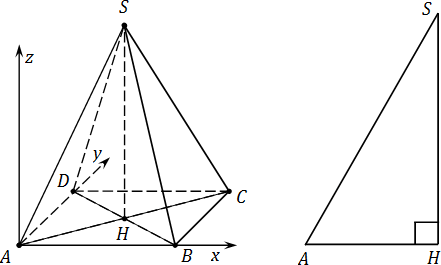We continue to consider the tasks included in the Unified State Examination in mathematics. We have already studied problems where the condition is given and it is required to find the distance between two given points or an angle.
In this article we will look at problems to solve a regular pyramid. These are pyramids at the base of which lies regular polygon(in the presented problems equilateral triangle or square).
You need to find some element, lateral surface area, volume, height. Of course, you need to know the Pythagorean theorem, the formula for the area of the lateral surface of a pyramid, and the formula for finding the volume of a pyramid.
In the article " " presents all the formulas that are needed to solve. So, the tasks:
SABCD dot O- center of the base,S vertex, SO = 51, A.C.= 136. Find the side edgeS.C..

IN in this case the base is a square. This means that the diagonals AC and BD are equal, they intersect and are bisected by the intersection point. Note that in correct pyramid the height dropped from its apex passes through the center of the base of the pyramid. So SO is the height and the triangleSOCrectangular. Then according to the Pythagorean theorem:
How to extract the root from large number.
Answer: 85
Decide for yourself:
In a regular quadrangular pyramid SABCD dot O- center of the base, S vertex, SO = 4, A.C.= 6. Find the side edge S.C..
In a regular quadrangular pyramid SABCD dot O- center of the base, S vertex, S.C. = 5, A.C.= 6. Find the length of the segment SO.
In a regular quadrangular pyramid SABCD dot O- center of the base, S vertex, SO = 4, S.C.= 5. Find the length of the segment A.C..
SABC R- middle of the rib B.C., S- top. It is known that AB= 7, a S.R.= 16. Find the lateral surface area.

The area of the lateral surface of a regular triangular pyramid is equal to half the product of the perimeter of the base and the apothem (apothem is the height of the lateral face of a regular pyramid drawn from its vertex):
Or we can say this: the area of the lateral surface of the pyramid is equal to the sum three squares side edges. The lateral faces in a regular triangular pyramid are triangles of equal area. In this case:

Answer: 168
Decide for yourself:
In a regular triangular pyramid SABC R- middle of the rib B.C., S- top. It is known that AB= 1, a S.R.= 2. Find the lateral surface area.
In a regular triangular pyramid SABC R- middle of the rib B.C., S- top. It is known that AB= 1, and the area of the lateral surface is 3. Find the length of the segment S.R..
In a regular triangular pyramid SABC L- middle of the rib B.C., S- top. It is known that SL= 2, and the area of the lateral surface is 3. Find the length of the segment AB.
Task 14. In a regular quadrangular pyramid SABCD with vertex S the side of the base is 6. Point L is the middle of the edge SC. The tangent of the angle between lines BL and SA is equal to 2.
a) Let O be the center of the base of the pyramid. Prove that the lines AS and OL are parallel.
b) Find the surface area of the pyramid.
Solution.
A) At the base of a regular pyramid is a square, that is, ABCD is a square. The diagonals in a square intersect at point O and are bisected by this point. Point L is the middle of SC according to the problem conditions. It follows that OL is the midline of triangle SAC and, therefore, and .
b) First, let's find the length of the side edge AS. Taking into account point a) we can conclude that the problem gives the value ![]() (see picture). Consider an isosceles triangle DLB (since DL=LB), in which point O lies in the middle of BD, therefore, LO is the median and altitude of triangle DLB, that is, triangle LOB is right-angled. Then we can write that
(see picture). Consider an isosceles triangle DLB (since DL=LB), in which point O lies in the middle of BD, therefore, LO is the median and altitude of triangle DLB, that is, triangle LOB is right-angled. Then we can write that
![]() .
.
In turn, OB is equal to half BD and from the right triangle BDC according to the Pythagorean theorem, we have:
![]()
![]() .
.
In point a) it was shown that, that is
March 9, 2012
When solving Problem C2 using the coordinate method, many students face the same problem. They can't calculate coordinates of points included in the formula dot product. The greatest difficulties arise pyramids. And if the base points are considered more or less normal, then the tops are a real hell.
Today we will work on a regular quadrangular pyramid. There is also a triangular pyramid (aka - tetrahedron). It's more complex design, so a separate lesson will be devoted to it.
First, let's remember the definition:
A regular pyramid is one that:
- The base is a regular polygon: triangle, square, etc.;
- An altitude drawn to the base passes through its center.
In particular, the base of a quadrangular pyramid is square. Just like Cheops, only a little smaller.
Below are calculations for a pyramid in which all edges are equal to 1. If this is not the case in your problem, the calculations do not change - just the numbers will be different.
Vertices of a quadrangular pyramid
So, let a regular quadrangular pyramid SABCD be given, where S is the vertex and the base ABCD is a square. All edges are equal to 1. You need to enter a coordinate system and find the coordinates of all points. We have:
We introduce a coordinate system with origin at point A:
- The OX axis is directed parallel to the edge AB;
- OY axis is parallel to AD. Since ABCD is a square, AB ⊥ AD;
- Finally, we direct the OZ axis upward, perpendicular to the ABCD plane.
Now we calculate the coordinates. Additional construction: SH - height drawn to the base. For convenience, we will place the base of the pyramid in a separate drawing. Since points A, B, C and D lie in the OXY plane, their coordinate is z = 0. We have:
- A = (0; 0; 0) - coincides with the origin;
- B = (1; 0; 0) - step by 1 along the OX axis from the origin;
- C = (1; 1; 0) - step by 1 along the OX axis and by 1 along the OY axis;
- D = (0; 1; 0) - step only along the OY axis.
- H = (0.5; 0.5; 0) - the center of the square, the middle of the segment AC.
It remains to find the coordinates of point S. Note that the x and y coordinates of points S and H are the same, since they lie on a straight line, parallel axis OZ. It remains to find the z coordinate for point S.
Consider triangles ASH and ABH:
- AS = AB = 1 by condition;
- Angle AHS = AHB = 90°, since SH is the height and AH ⊥ HB as the diagonals of the square;
- Side AH is common.
Therefore, right triangles ASH and ABH equal one leg and one hypotenuse each. This means SH = BH = 0.5 BD. But BD is the diagonal of a square with side 1. Therefore we have:
Total coordinates of point S:

In conclusion, we write down the coordinates of all the vertices of a regular rectangular pyramid:

What to do when the ribs are different
What if the side edges of the pyramid are not equal to the edges of the base? In this case, consider the triangle AHS:

Triangle AHS - rectangular, and the hypotenuse AS is also a side edge of the original pyramid SABCD. Leg AH is easily calculated: AH = 0.5 AC. We will find the remaining leg SH according to the Pythagorean theorem. This will be the z coordinate for point S.
Task. Given a regular quadrangular pyramid SABCD, at the base of which lies a square with side 1. Side edge BS = 3. Find the coordinates of point S.
We already know the x and y coordinates of this point: x = y = 0.5. This follows from two facts:
- The projection of point S onto the OXY plane is point H;
- At the same time, point H is the center of a square ABCD, all sides of which are equal to 1.
It remains to find the coordinate of point S. Consider triangle AHS. It is rectangular, with the hypotenuse AS = BS = 3, the leg AH being half the diagonal. For further calculations we need its length:
Pythagorean theorem for triangle AHS: AH 2 + SH 2 = AS 2. We have:
So, the coordinates of point S:

In a regular quadrangular pyramid SABCD, point O is the center of the base, SD=26, AC=20. Find the length of segment SO.
The solution of the problem
The video lesson presents a computational problem from the Unified State Exam (B13) to find the side edge of a quadrangular pyramid. When solving the problem, remember that the height in a regular quadrangular pyramid is the segment that connects the top of a given pyramid with the center of the base. The concept of a regular quadrangular pyramid is used. This is a pyramid with a square base and side ribs are equal. It is concluded that the point in the center of the square divides the diagonal into two equal parts. A right triangle is considered. To find the leg in right triangle Pythagorean theorem is used: square of the hypotenuse equal to the sum squares of legs. The desired quantity is expressed.
The solution to this problem is intended for 10th grade students when studying the topic: “Correct pyramid” (The concept of a regular pyramid. Solving problems). The educational video lesson will be useful for 11th grade students in preparing for the Unified State Exam.
